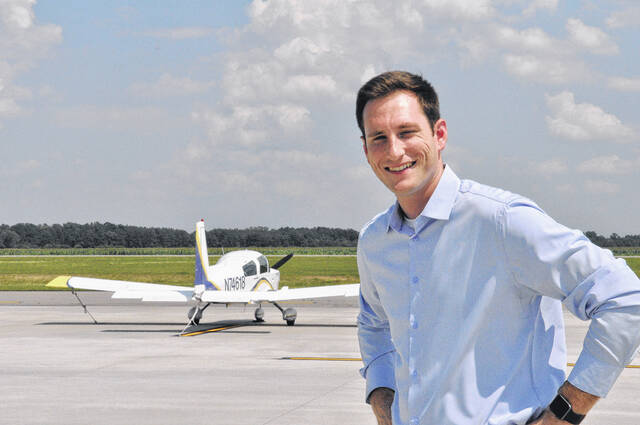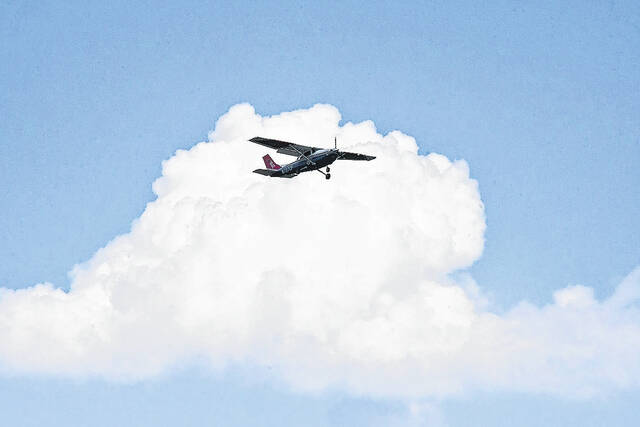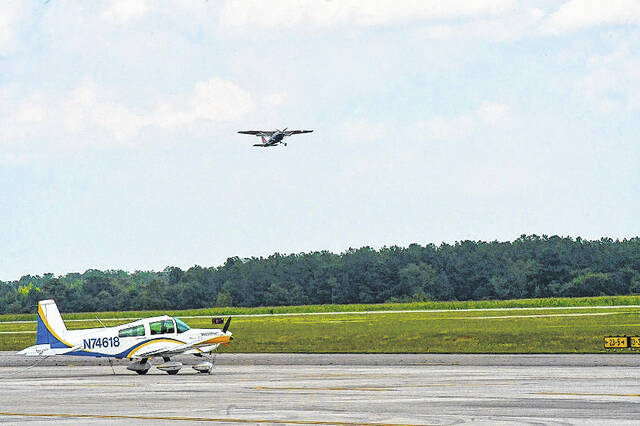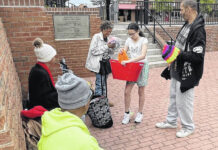ROBESON NEIGHBORS Q&A
MAXTON — The Southeast Regional Airport Authority operates the Laurinburg-Maxton Airport.
It serves private individuals, business and military aviation along with operating as an intermodal facility to support an industrial park.
The airport was built as a full military base with complete infrastructure on a huge parcel of land providing it with many options for growth.
The small airport general aviation airport still owns approximately 3,200 acres placing it in a unique position for outsized growth.
Most general aviation airports have hundreds of acres in contrast to L-M. For instance, Moore County Airport of Pinehurst has 500 acres and Lumberton Airport 485 acres and Fayetteville Regional Airport which offers commercial service has only 1,343 acres.
“Our goal is to grow the aviation side, but it’s also to grow our industrial park and bring jobs back into rural North Carolina. We’re an economic development engine out here,” said Seth Hatchell, the new executive director of the Laurinburg-Maxton Airport.
Q: When did you come to Laurinburg-Maxton Airport?
SH (Seth Hatchell) : I’ve only been out here since 2019. And I just became the executive director about six months ago. So, I’m feel like I’m still learning new things about this place, and especially with the rich history that we have out here. I’m just doing my best to preserve it and let other people know about it. Because it is a very unique place, and we’re happy to talk about it. A lot of people don’t know about us, and we’re trying to change that.
Q: What is unique about L-M Airport?
SH: We’re unique for a couple of different reasons. We’re a former Army Air Base. Most airports struggle for land, they’re always looking to buy more land or over the years, they’ve sold land to people and now they’re trying to get that land back because it’s precious. Well, when the Army Air Base was given over to Laurinburg and Maxton back in the 40s, they gave them the three runways, the taxiways, all the aviation infrastructure, and they also gave them all the land around the airbase, which was about 4,500 acres. So that’s a lot of land. We do not struggle for land.
The first thing that the Commission(airport) did because of their foresight, they built this industrial park. We are fortunate to have some different industries in our park that are right by an airport. We also have property adjacent to 74 (highway). And we also have rail that comes on site out here at the airport. We’re truly an intermodal facility with air potential, we have interstate potential in the future. And then of course, with rail service sites as well.
And because it was a former Air Base, we had a water and sewer infrastructure that was put in place out here. The airport actually owns and operates a water and sewer system here. Not only do we have aviation, and we also have water and sewer that we also do, and so that that comes from all we have seven active wells, we pull the water up out of the ground, we sell it to the different industries in our industrial park, and then we take their waste and we send it to our wastewater plant, that’s also an airport property. So, we have a whole separate entity and revenue stream that we get from that as well. The operation of sewer and water systems is unique for an airport.
Q: Does L-M Airport have the capacity to handle some unusually large and heavy aircraft unlike many smaller facilities?
SH: We do have a fairly large runway for a small general aviation airport, our runway is 6,500 feet long, and it’s 100 feet wide. And it’s all brand-new asphalt, I say brand new it was it was put down in 2011, it was completely rehabbed. And we don’t advertise this very much. But before 2011, when it was rehabbed, it was the original concrete from 1942, when it was installed, It wasn’t in the best shape by any means. After what is that 70 years, we were fortunate to get it completely rehabbed. And then in 2013, we had a brand-new taxiway that went along with it. And of course, I mentioned earlier, it’s a good size, which means we’re able to accommodate larger aircraft and heavier aircraft. But we are still limited, depending on the weight of the aircraft.
The runway is that long and that wide because it was part of a former military installation that was built in 1942. There were three runways, it was the largest facility in the world for training glider pilots at the time, from 1942 until 1945. And then once World War II ended, the Laurinburg-Maxton Army Air Base was given to the city of Laurinburg and the town of Maxton to run as a general aviation airport. And for the last, not quite 80 years. But certainly, creeping up on it very soon. It’s been run that way by the Laurinburg-Maxton Airport Commission. And in 2020, the name of the airport commission was changed to the Southeast Regional Airport Authority. And that’s who governs our property, our aviation, as well as our water and sewer infrastructure out here.
Q: That’s interesting. When you said the airport can handle bigger craft, but it depends on the weight. Could you bring a huge military plane in here?
SH: We do have active operations of C130s (transport), which is a fairly large military aircraft. And to my understanding, we have landed some C17s as well, which is a little bit larger than the C130. Now, we’ve never had a C5 Galaxy fly in before, I think that (C5) is the largest military aircraft. But we do have C130s come in, quite regularly.
Q: Why do military planes come to Laurinburg-Maxton when in nearby Fayetteville, there’s Pope Air Force Base.?
SH: When public airports like us accept federal or state dollars, we have what’s called grant assurances, and there’s 39 of them that we’re supposed to adhere to and comply with. And one of those grant assurances just says, “Hey, if you accept the federal dollar, any government or military aircraft have to be able to utilize that airfield for any reason–for training purposes, if they need to.” So, we find especially because we are in such close proximity to Fort Bragg, they like using our airspace because it’s relatively uncongested.
Q: What is the benefit to the military of coming to L-M?
SH: There’s a couple reasons, but one is the uncongested airspace. Well, at Pope Air Force Base, they have a control tower, and they have traffic control that you talk to in and out. Here at Laurinburg-Maxton, we do not have a control tower. We are what’s considered uncontrolled airspace. So, it’s up to the pilot to operate on our CTAF (Common Traffic Advisory Frequency) or UNICOM (talk to airport staff), and they tune to that frequency, and they’re supposed to communicate on it. And all the pilots in our vicinity, they listen to that frequency, and they know who is where on the airfield. So, it’s not a controlled airspace, so they have a little bit more flexibility in what they do. The second reason they like operating on our airfield because we have a relatively wide-open facility. So, we have a large runway, which is larger than most general aviation airports, which, of course the military like, because of their stuff, larger runways, of course, at the Air Force bases and the army airfields. But, we have two active drop zones on the field out here, we have DZ1, which is predominantly used by the US Army Golden Knights, and then we have DZ2, which is used by other operations. So, a lot of times we’ll get traffic that’s come just to use the drop zones and for parachute training, and skydiving and what not.
Q: What about future development since you have all this land? Are you planning to do more? You have an industrial park? What’s in there? What’s the growth potential?
SH: We have about 13 to 14 different industries across our industrial park. So, we’ve got all sorts of different industry out here. And in the last five years, I believe we’ve had three different expansions of industry. And then we’re actively talking with one or two about new locations out here and what we can do on that front. We’re continually looking to try and grow our industrial park and provide better service to our customers, because we understand that really, our goal is twofold: to grow the aviation side, but it’s also to grow our industrial park and bring jobs back into rural North Carolina. We’re an economic development engine out here. And we also because we own so much land, we leased some of it out to farmers, we have a warehouse that we own in the industrial park. We’re also we have a lot of irons in the fire. And a lot of airports don’t have the luxury of having. We’re very, very fortunate. And we’re very, very proud of it as well.
Q: I have heard mention of a “boneyard” on site. Does that still exist?
SH: Yes. We have a tenant on the airfield and they go by the name of the Charlotte Aircraft Corporation. They will purchase old airliners that have served their useful life and the airlines, and they’ll fly them in and they’ll salvage them. They take all the parts that they can and sell them back to the corporate sector. And then they’ll start scrapping them. So, we have some really cool things on site.
Q: What other interesting tenants are on site?
SH: We’ve got a couple of really cool tenants out here. We have the Griffin Group Security Solutions, so they do some paramilitary training, they also lease some land from us.
Q: What is the purpose of this paramilitary group? Are they private? Are they similar to the Wagner group the Russians have? Is it something like that?
SH: So, they would be considered a private group. They, they were founded years ago down in Melbourne, Florida by some veterans. In 2009, they moved up here to the Laurinburg-Maxton Airport to set up their home base. And then about two years ago, they were purchased by a parent company called Raven Advisory. But when I say paramilitary, they are just veterans, they train active-duty military personnel. So, they will do pre-deployment training. So, units will often come to their facility, get some specialized training before going out and serving our country overseas. They do some cool stuff here at the Laurinburg-Maxton airport. Most of that is ground-based training. It’s not directly affiliated with the airport, it’s kind of their own little thing.
Q: What other military activity takes place regularly at L-M?
We also have the Golden Knights (part of the U.S. Army Parachute Team), which do jumping here just about every day. They do all their training here at the Laurinburg- Maxton airport. And when they when they jump with some of their VIPs and stuff. They’ll also do it out here. Sometimes they’ll do it in Texas, sometimes they’ll do it here. But we’re happy to support them in a way that we can as well. We also have some newcomers to the field, we’ve got some mechanics and a flight instructor that they’re both still active-duty military, but when they’re not serving, they’re here they’re working on planes are flying people around. We’re excited to have the develop a new partnership with them as well.
Q: Is the airport tasked with handling emergency services? Say, there’s a hurricane or disaster? Do you have facilities to help bring in supplies and things like that?
SH: Yeah, so we don’t have anybody truly on site. Other than we have a company called MedTrans Corporation, and they’re under contract with Scotland Memorial Hospital for MedEvac purposes. They rent our larger hangar out from us, which is about an 8000 square foot hangar. They do light maintenance in that hangar, and they’re also put the aircraft in there during bad weather. We do a demonstration once a year with them.
But even more than that, we have a great relationship with the city of Laurinburg Fire Department, with the Scotland County Sheriff’s Office. We coordinate with them on different things. And when they have emergencies out here, they make sure they coordinate with us and we get them on the active airfield. We do have a demonstration about once a year, the Golden Knights will organize a “simulated emergency” or they pretend that they’ve had some sort of accident happened, whether it’s a failed parachute or whether it’s an engine that’s gone down on an aircraft. And so, they’ll coordinate with the local emergency operations and make sure that, hey, if this were to happen, these are the procedures we’re looking at this is what you need to do. This is the standard operating procedure.
Q: Besides the new name, what is the plan for the Southeast Regional Airport Authority?
SH: So, a couple years ago, we rebranded as the Southeast Regional Airport Authority. And we’ve really had this new idea of pushing, hey, this is a diamond in the rough. We had a local Senator McInnis and he said, you know, you have this amazing facility, and you really need to broadcast and you need to get it out. And about a couple months after that I was hired. And then the last three, four years, it’s really been our mission to promote that we have an incredible facility. Let’s market it. Let’s let people know that we’re here. And let’s try and keep this economic engine rolling. Because we have so much opportunity here and so much more than we can bring to this area.
And we have mostly military we have a big military presence. We also have general aviation, which would be smaller planes typically. So we would have two-seaters, four seater, six seater planes and aircraft. And we have about 20 hangers out here, at the Laurinburg-Maxton airport. So, people rent hangars from us, and then they can keep their plane there and then fly, you know, on the weekends or the weekdays whenever they’d like. And because of the industrial park, we also do get some corporate traffic. So, we’ll get some corporate aircraft that fly in to go look at the different facilities and check in on things. We get a little bit of that but as of right now, we do not have any charter or commercial service, but we’d love to get there one day.
Q: Other recent upgrades? Changes planned?
SH: We certainly do. We just took over the fueling operation in January. Prior to that we had a private company that did all of our fueling and our hangar rentals. Over the last, probably six months now, but now we rent all the hangars out, we do all the fueling operations for all the aircraft here. And I really encouraged our guys and said, “Hey, look, this is a blank slate. You know, there’s already some really cool stuff happening here. But there’s still so much potential with all this land that we have in future development, you really have an opportunity to put your name on it as well as the names of Scotland County and Laurinburg, and Maxton in Robeson County. So do you make money, this is a positive income situation. So, we are fortunate.”
Most small airports typically function as almost a department of the local city or the local county that owns them. So, (L-M) almost is just like a city or county department. And so, we’re actually completely self-sufficient. The city of Laurinburg and the town of Maxton, they own us, and then the mayor’s appoint members to our board. But then the airport authority is what governs the airport and our revenue and our income and our expenses. But we don’t receive any dollars from the city, the town or the county. So, all the money that we make here, we’re able to then reinvest back into our facility. We’re very, very fortunate that we do run in the black, we do not run in the red.
Q: Okay, but what if there is a surplus, can the Authority just keep it? Do you have to hand it off to Laurinburg and Maxton?
SH: When we plan our budget, we always plan it to be a zero budget. We operate very, very similar to a city or a town. And so, a lot of our money is what would be considered enterprise funds, especially on the water and sewer side. But we take all that money and then we plan just to go back and reinvest it back into our water, sewer infrastructure, or in our aviation infrastructure. We don’t really just sit on the money and collect it like a greedy landlord–we’re not at all about that. We’re all about reinvesting back in our facilities, we have this great asset. And the only reason it stays a great asset or becomes better is if we’re putting money back into it.
Q: What is the goal down the line?
SH: Yeah, it’s great question that you asked. We just underwent some strategic planning through the division of aviation in the Department of Commerce about a year and a half ago. And we were one of the first two airports to start the strategic plan program to the state. It was us and the Mount Airy Surry County Airport. Through that, we were able to bring in our stakeholders we were able to bring in all these other people, the city, the town, the county’s economic development, different customers and industrial customers. And we said, you know, “Hey, what is our goal? What is our 5-10, 15-20 year-plan and what are we looking forward to?” And something that really came out of the strategic plan was growing our general and corporate aviation customer base. We saw that we had a huge tilt towards military, which is fine, and we want to keep that going. But we really saw a need to grow our corporate and general aviation as well. Because when you when you lean too heavy on one sector, and that sector falls, you’re just shooting yourself in the foot. So, we’re gonna go after these other markets, we’re gonna go after smaller aircraft, we’re gonna go after corporate aircraft as well, and entice them, and show them the amazing facility that we have. So that was one thing. Another thing was reinvesting in our infrastructure. So, for years, it’s an 80-year-old facility. So of course, you’re going to have normal wear and tear and something we hadn’t done as well was reinvest back in the facility.
We also saw that there were some customer service issues or some disconnects. So, the first thing we said is, well, how do we fix that? How do we make this the best facility both for water and sewer customers who might have questions about billing, but also about aviation customers who fly in, we want to roll out the red carpet for everyone, whether they’re in a little two-seater plane, or whether they’re in a $50 million Gulfstream, we want everyone to be equal, and we want everyone to feel treated with respect, and that they can come into Laurinburg-Maxton, and get a first class experience.
Q: How are you doing that?
SH: As we’ve taken over the fixed base operation in the last six months is, it is how we deliver that Prime customer service to everybody and make them leave positive reviews and make people want to see what’s going on here? What’s different, and I feel like we’ve, we’ve done a great job of that if you look at ForeFlight, which is a pilot app, or air NAB, which are common websites used by pilots, and the last six months, I think we’ve had five or six positive, glowing reviews about our FBO, our fixed base operation that sells fuel. And that’s just really, really exciting to see, because that’s something we’re really striving for.
Last Saturday the Airport Authority hosted a luncheon for their aviation customers.
“So, all the people who rent hangars out here all the people who might be entwined with our aviation facilities, we’re kind of owe them a little appreciation lunch, hey, thank you for using us, thank you for choosing us to deliver a service to you. Have a hamburger, have a hot dog, and let’s meet and greet. Let’s get to know one another and see what we can do to continue improving operations,” Hatchell said.







